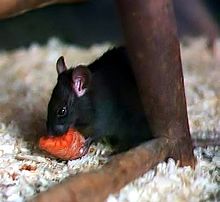Black rat
| Black rat | |
|---|---|
 |
|
| Rattus rattus | |
| Scientific classification | |
| Kingdom: | Animalia |
| Phylum: | Chordata |
| Class: | Mammalia |
| Order: | Rodentia |
| Family: | Muridae |
| Genus: | Rattus |
| Species: | R. rattus |
| Binomial name | |
|
Rattus rattus (Linnaeus, 1758) |
|
The black rat (Rattus rattus), also known as the ship rat, roof rat, house rat, is a common long-tailed rodent of the genus Rattus (rats) in the subfamily Murinae. The species originated in tropical Asia and spread through the Near East in Roman times before reaching Europe by the 1st century and spreading with Europeans across the world.
Black rats are generalist omnivores. They are serious pests to farmers as they eat a wide range of agricultural crops.
The black rat was one of the many species originally described by Linnaeus in his 18th century work, Systema Naturae, and it still bears its original tautonym of Rattus rattus. It is the type species of the genus Rattus.
A typical adult black rat is 12.75 to 18.25 cm (5.02–7.19 in) long, not including a 15 to 22 cm (5.9–8.7 in) tail, and weighs 75 to 230 Gramms, depending on its subspecies. Despite its name, the black rat exhibits several colour forms. It is usually black to light brown in colour with a lighter underside. In England during the 1920s, several variations were bred and shown alongside domesticated brown rats. This included an unusual green tinted variety. The black rat also has a scraggly coat of black fur, and is slightly smaller than the brown (Norway) rat.
Rattus rattus bone remains that date back to the Norman Period have been discovered in Britain. Evidence also suggests that R. rattus existed in prehistoric Europe as well as the Levant during post-glacial periods. The specific origin of the black rat is uncertain due to the rat's disappearance and reintroduction. Evidence such as DNA and bone fragments also suggests that the rats did not originally come from Europe, but migrated from southeast Asia.
Rats are resilient vectors for many diseases because of their ability to hold so many infectious bacteria in their blood. Rats played a primary role in spreading bacteria, such as Yersinia pestis, which is responsible for the Justinianic plague and bubonic plague. A recent study indicates that other Asiatic rodents served as plague reservoirs, from which infections spread as far west as Europe via trade routes, both overland and maritime. Although the black rat was certainly a plague vector in European ports, the spread of the plague beyond areas colonized by rats suggests that the plague was also circulated by humans after reaching Europe.
...
Wikipedia

